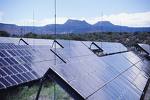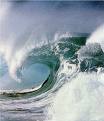According to
Professor Jesse Ausubel, professor of environmental science at Rockefeller University, renewable energy projects will do more harm than good for the environment in the long run. He claims that the vast amounts of land that would be needed to sustain the rate of the world's energy consumption would negate any benefit to the enviroment. Professor Ausubel's analysis, announced in a report on Wednesday, included such popular renewable energy sources such as wind turbines, biofuels and solar cells.
Professor Ausubel reached his findings by ranking each renewable energy source according to it's potential energy output per square meter. According to his findings, hydroelectric power in the form of dammed rivers produces the least amount of energy per square meter, at a paltry 0.1 watts. Biofuel crops and wind energy produced approximately 1.2 watts per square meter and photovoltaic energy cells produced the most energy at 6 -7 watts per square meter.
Under his analysis, to meet all the energy demands of the United States (using statistics from 2005), the US would need to build a wind farm the size of Texas and Louisiana combined. Professor Ausubel also calculated that providing enough energy to power New York City for one year would require a solar grid the size of the Connecticut.
While Professor Ausubel's analysis provides an interesting way of comparing renewable energy potential outputs to one other, it does a poor job of taking into account how these energies are practically implemented and integrated. These are technologies that can often be installed in and around existing infrastructure and would not require the dedication of new lands. For instance, solar cells are regularly installed on top of existing rooftops and buildings, and would not require additional acres of land. His analysis also does not take into account the prime rule of real estate: location location location. Meaning that wind turbines located in windy areas of the world will produce more energy than their calm wind counterparts.
Professor Ausubel's report also compares renewable energies to nuclear energy, which he unequivocally (and eyebrow-raisingly) touts as the greenest energy of them all. He claims that nuclear energy requires the least amount of land and provides the highest amount of energy output. This is comparing an energy apple to an energy mushroom (cloud that is). I'm sure he's correct when he says that one hectare of solar cells produces the same amount of energy as one liter of fuel in a nuclear reactor's core. However, solar cells - no matter how many you have - do not have the potential to melt down your neighborhood. Which, by the way, would really put a hurting on the environment. With solar cells and other renewable energy sources except for biofuel crops, once they have been installed, you "set it and forget it". There are no more investment costs to solar cells, save minor maintenance and repairs. The Professor does not go into detail about how much energy is used in creating nuclear energy, nor does he address the hazards of collecting nuclear waste indefinitely. Even Professor Ausubel admits that at best, nuclear waste can only be "contained", not neutralized and disposed of safely.
There's a fundamental difference in harnessing energy and creating energy. Both are far from perfect energy sources. However, there is something infinitely comforting about using a resource that already exists, capturing it for human use, and finding ways to make it sustainable indefinitely. At its core, it is recycling energy and you can't get any greener than that.
Nuclear energy, on the other hand, consumes vast amounts of energy to create and, while the output has the potential of being hundreds of times greater than the input, there also exists the potential of destruction hundreds of times greater than the input as well. The fact that we have not yet developed a way to dispose of nuclear waste is proof that it is not "green". As of right now, nuclear energy is more an imperfect resource than anything else. I have great hope that one day in the distant future, nuclear energy will be THE energy resource that Professor Ausubel claims it to be, and it should be studied carefully. I just don't believe that we are there technologically and may not be there for several decades. If researched responsibily, it SHOULD take decades to perfect. In the meantime, we have simple technologies that really work, that are sustainable indefinitely, and are truly renewable. In the scheme of things, renewable, not nuclear, energy, is the near future and nuclear (hopefully if all goes well and we don't blow ourselves up trying) is the distant future.
Professor Ausubel makes some great points in his analysis, however he is touting nuclear energy as "green", decades prematurely.
Labels: biofuel, nuclear, renewable energy, solar, wind




